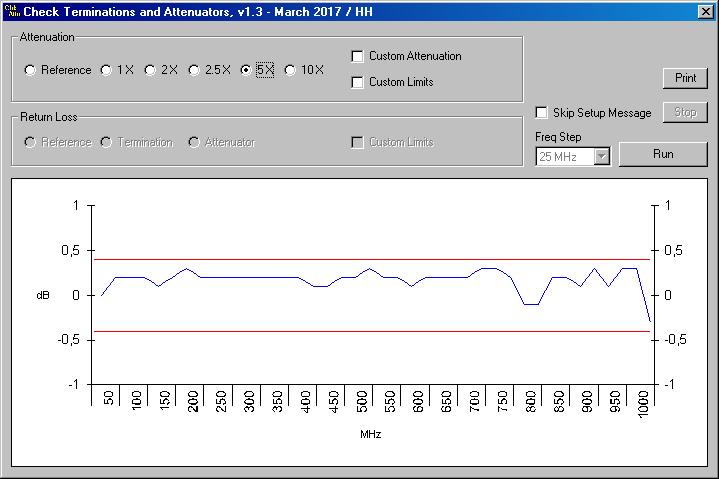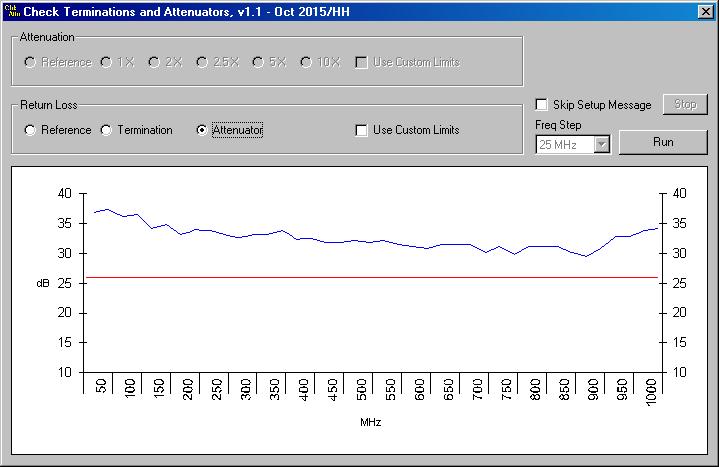
Check Terminations and Attenuators
This program emulates what a Network Analyzer could do if you want to check 50 Ohm Terminations or Attenuators.
It requires a Tek 27xx Spectrum Analyzer with GPIB, Tracking Generator and a good Impedance Bridge e.g. Wiltron 60N50.
It was written using a 2710 but will also accept 2711 and 2712 however I have not confirmed that they also work (i.e. have the same GPIB command set).
Nov 29, 2017 - New version 1.4
Bugfixes:
When using 12.5 MHz Frequency
steps the first step was too close to the zero spurios causing an invalid
measurement
value - now measurements starts at 25 MHz when 12.5 MHz steps are
used.
Custom Attenuation didn't accept dB settings with decimals.
A few commands that could cause Run Time Error on some OS were removed.
"Getting Values Done" message said Return Loss also for Attenuation.
When printing the Options for selecting DUT were swapped between Attenuation and Return Loss.
Print button became enabled after Run was cancelled.
Clicking inside the Atten frame when Custom Attenuation was selected forced a new reference sequence to be executed.
Changes:
"Skip Setup Message" option changed to "Skip Messages" and now includes "Done" message.
Entry check for Custom Attenuation moved to Run from check during typing.
Query to initialize the S/A added when the program is terminated.
Changes from 1.2 to 1.3
Bugfixes:
Most of the procedures to set up the S/A was totally rewritten. The reason for that is that unlike any other Tek instrument I have come across the INIT command does
not set the instrument to a known Factory Default setting but rather to a User Defined setting which I wasn't aware of when I wrote the first versions of this program.
The effect was that it worked fine on my 2710 but probably not at all on somebody else's. Now it initializes to Factory Default as it was intended to from the beginning.
Tab indexes were in wrong order.
Changes:
Info box flashing red on startup to alert the user.
Option for Custom Attenuation added to Attenuation Measurement.
Text changed on several places and some info boxes added.
An info line added to the Attenuation printout.
Changes from 1.1 to 1.2
Bugfixes:
Empty or zero attenuation limits not allowed anymore.
If a Reference sequence was Canceled before it started the Freq Step drop-down list didn't become enabled.
Changes:
Minor text changes to some pop-up setup boxes.
Custom Limits now allowed for x1 Attenuaors. Previously no limits were shown
New:
Function to print the graph added. See a pdf example of a printout here.
Changes from 1.0 to 1.1
Changes:
Added one Attenuation Option to check 1X attenuators i.e. cables.
One setup message changed to read Termination rather than Terminator.
Version 1.0
Initial version.
Here are a couple of screen shots of a good 5X attenuator being tested.


Two modes are available, Attenuation and Return Loss, i.e. VSWR.
The standard limits are those given by Tek. Custom limits can also be selected by checking the "Use Custom Limits" box.
Attenuation limits for Tek attenuators, 011-00xx-02, are ±0.4 dB for 5X and 10X and ±0.3 dB for 2X and 2.5X.
Return Loss limits for Tek attenuators is ≤1.1 (≥26 dB) and for terminations (011-0049-01) ≤1.2 (≥21 dB).
All specs are DC to 1 GHz.
The function is rather simple. It first sets the S/A to record a reference which the actual DUT is then compared to and the result is calculated.
The limits are drawn as reference only and no warning will be issued in case a limit is exceeded.
There are four Frequency steps to select from (12.5, 25, 50 and 100 MHz) of which off course 12.5 MHz will give the most accurate result.
You must have an NI GPIB card with the proper drivers installed. Find and download National Instruments GPIB card drivers here.
It is expected to work on any PC/win OS (not 3.1) with a correctly installed and working NI card.
Be sure to uninstall any previuos version before installing this one or extract the *.exe file from the *.CAB file and replace your current file.
Download Check Terminations and Attenuators here
Email me with comments. /Håkan
Home / Go back